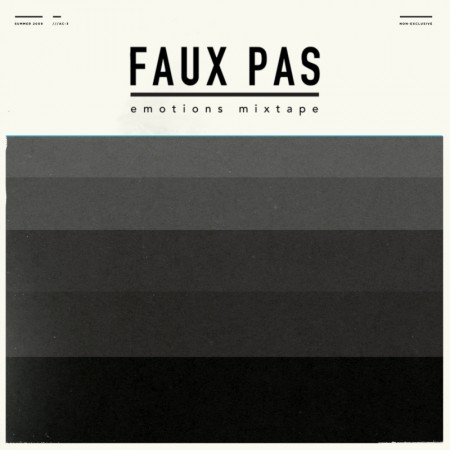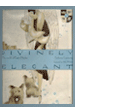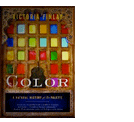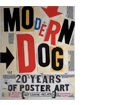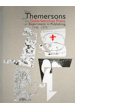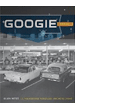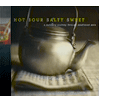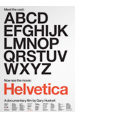Seeing stars!

Award-winning magazine designer Jason Malmberg made me a logo.
He said, ‘It’s not quite what I envisioned. I’m still trying to find a way to give a lens flare TO a lens flare.’
If you don’t see the humor, you’re reading the wrong blog.
To see Jason’s real work, check out Sactown magazine, one of the best city/metropolitan magazines in the country. (So good, even local competitor Sacramento Magazine has reformatted to be a bit more like Sactown. I always see that as a nice compliment.)
But if you want the real deal, the October/November 2009 Sactown (above) just dropped. It should be showing up on select newsstands just about now (Sactown is distributed nationally). Or subscribe here.
Faux Pas
Faux Pas, Tim as a Brim
Melbourne-based DJ Tim Shiel is Faux Pas – and I found his work just a few months ago via Scott Hansen’s ISO50 Blog.
The Faux Pas Emotions Mixtape is a great download; just pop over to ISO50 and right click on the ‘DOWNLOAD THE MIX HERE’ link to snag the 44 minute MP3.
Plus, check out the Faux Pas blog here.
Free Waterfalls EP download at The Faux Pas Rad Web Store.
And here’s another video to chew on . . .
Faux Pas, Coach
Good grade: d++

Marko Davidovic is an artist and graphic designer out of Belgrade. I love the expressive freedom in his art – it just totally syncs with me – in each medium he works, his energy explodes.
He’s always posting something interesting on my MySpace page – ‘just fooling around,’ is his MySpace approach. His work, however – calligraphic, canvas, photographic, illustrative, digital – is something else.
He goes under the tag of d++. Find him on MySpace here.

Wolf
Insides – SEO MArketing Tips
Throughout all of 2017, HubSpot experienced something that had never happened before — our blog’s monthly traffic flattened. Even worse, it started to decline. So after months of stressing over the mysterious cause of our blog’s traffic plateau, we decided to sit down, chug a bunch of coffee, and find the culprit.
What we discovered is that our editorial strategy of brainstorming topics and relying on our intuition to determine our audience’s content preferences didn’t suffice anymore. And coupled with almost every social media platforms’ unwillingness to direct users off their website and the ever-growing mountain of emails piling up in people’s inboxes, we decided to pivot and focus our energies on the channel that has consistently generated the majority of our blog’s traffic for its entire existence — organic search.
Today, almost a year after we implemented our organic-only strategy, we’ve exceeded the majority of our monthly traffic goals and even broke some monthly traffic records. Needless to say, we’re thrilled (and relieved) that our new organic-only strategy fueled our traffic boost and shattered the great traffic plateau of 2017 — and we’d love to share the essential SEO tips that helped us devise this strategy.
Access Now: 22 SEO Myths to Leave Behind This Year
SEO Tips
- Optimize your content for people before search engines.
- Leverage the pillar-cluster model.
- Develop a link-building strategy.
- Implement a historical optimization strategy.
- Compress your images.
1. Optimize your content for people before search engines.
Even though an algorithm dictates the order of Google’s search engine results pages, you must remember that Google designed its algorithm to reward the web publishers that craft the best content on the internet, not the web publishers that are the best at gaming their algorithm.
In fact, part of Google’s search algorithm ranks your content based off engagement metrics, like total traffic, organic traffic, direct traffic through Chrome, time on site, bounce rate, SERP CTR, brand mentions on authoritative sites, and return visits.
So, to boost your website’s engagement and, in turn, your domain authority, there’s really only one way to do it — you must attract and engage a loyal audience by creating high-quality content. Only then should you start optimizing it for search engines.
The first step we usually take when optimizing our content for people is understanding the intent behind a keyword we want to target. To do this, we analyze the keyword’s search engine results page and determine the problems users are trying to solve when searching for this query.
After that, we figure out how to effectively solve these problems by mining information from trusted sources, examining our own research, and asking HubSpot employees who experience similar problems the steps they take to solve them.
The final and most important step of our content creation process is crafting the most engaging content possible. To do this, we tell stories and relate to our audience’s problems in our introductions, write clear, concise, and compelling copy, highlight interesting findings, data, and quotes in our body text, and include vivid images and videos to provide a variety of stimuli. At the end of each blog post, we keep the momentum going and remind our audience of the thoughts and emotions they just experienced, which leaves them yearning for more content.
2. Leverage the pillar-cluster model.
Since people heavily rely on Google to provide accurate and relevant answers for most of their questions today, Google needs to understand the intent and context behind every single search. To do this, Google has evolved to recognize topical connections across users’ queries, look back at similar queries that users have searched for in the past, and surface the content that best answers them. As a result, Google will deliver content that they deem the most authoritative on the topic.
To help Google recognize our content as a trusted authority on marketing, sales, and customer service topics, we decided to implement the pillar-cluster model on our blog. By creating a single pillar page that provides a high-level overview of a topic and hyperlinks to cluster pages that delve into the topic’s subtopics, we could signal to Google that our pillar page is an authority on the topic.
Hyperlinking all of the cluster pages to the pillar page also spreads domain authority across the cluster, so our cluster pages get an organic boost if our pillar page ranks higher, and our cluster pages can even help our pillar page rank higher if they start ranking for the specific keyword they’re targeting.
Another benefit the pillar-cluster model supplies is cleaning up our site infrastructure and providing a better user experience for our website visitors. Before we implemented the pillar-cluster model, we spent most of our time writing blog posts designed to rank for specific, long-tail keywords. This resulted in thousands of unorganized blog posts, and some were so similar that they competed with each other on the same search engine results pages. Here’s a visualization of what our site architecture used to look like:
However, by organizing our blog into topic clusters, our site architecture currently looks like this:
Now, not only is it easier for Google to crawl our blog, identify semantic relationships between our posts, and boost our search engine visibility, it’s also easier for our audience to search for the content topics they’re looking for, find related content, and spend more time reading our blog posts.
To learn how to implement the pillar-cluster model on your own blog, take a look at the steps we took to do it.
3. Develop a link-building strategy
Earning high-quality inbound links from websites and pages with high authority scores is crucial for boosting your domain authority. But, unfortunately, “If you write it, they will link to it,” is not a viable SEO tactic.
The main method we use to earn high-quality links is by networking with other websites that have a higher domain or page authority score to link to our top content. We also make sure our content is relevant to the referring website’s content.
Another way you can earn quality backlinks is by using Backlinko’s skyscraper method. The skyscraper method is an SEO strategy where you find content that ranks well for keywords you want to rank for and then create content that’s better than the top ranking posts. Then, you use SEO tools to find all the sites that have linked to your competitor’s content and ask the most relevant sites to replace your competitor’s link with a link to your improved content.
In 2016, Backlinko asked 160 websites to link to their post about Google’s 200 Ranking Factors and they earned 17 inbound links. You might be thinking that 17 backlinks isn’t that much, but a lot of those referring websites had high domain authority scores, so the post’s organic traffic increased by 110% in only two weeks.
4. Implement a historical optimization strategy
In 2015, Pam Vaughn, the current Principal Marketing Manager of HubSpot’s Web Strategy Team and former Editor of HubSpot’s Marketing Blog, made a revolutionary discovery about HubSpot’s organic monthly blog traffic — the overwhelming majority of it came from posts published prior to that month. In fact, 76% of our monthly blog views came from these old posts.
Today, Pam’s groundbreaking revelation rings louder than ever — 89% of our monthly blog views currently come from posts that were published at least six months prior, and we’ve developed an entire strategy dedicated to refreshing and republishing these historical pieces of content.
We call these types of blog posts “updates”, and they comprise 35-40% of our editorial calendar. And by refreshing them with new information and SEO optimization and then effectively republishing them as new blog posts, we can build upon their existing organic value that they’ve accumulated through backlinks and user engagement and double or even triple their traffic. This process also helps us optimize our blog for efficiency, decreasing the amount of new content we have to create while increasing our organic traffic and conversions.
Historical optimization isn’t for everyone, though. It’s a strategy catered for a blog that generates a significant amount of organic traffic, has a considerable amount of blog subscribers and social media followers who can supply a surge of traffic, shares, and backlinks to your updates, and owns a substantial repository of old posts that are worth refreshing and republishing.
However, if you have all three of these things, we definitely recommend implementing a historical optimization strategy. To learn about the specific types of historical content you should update and the exact process of updating them, check out this blog post written by Pam Vaughn herself.
5. Compress your images
When you think about optimizing your content for search engines, compressing your images’ file size doesn’t seem like it should be a top priority. But, according to Braden Becker, HubSpot’s Historical Optimization Lead, your images’ file size directly affects your website’s page load speed, which is one of the ten most important Google ranking factors.
“The bigger an image’s file size, the longer it takes your web browser to load that image, which increases your website’s loading time as a whole. And the longer your website’s loading time, the more likely Google will penalize you,” he says.
Compression blends similarly colored pixels into single pixels to reduce the image’s resolution, and in turn, file size. But since the human eye is more sensitive to light and dark detail than color detail, we’re not able to detect the color differences between an uncompressed and compressed image, so the perceived quality stays the same, just like the pictures below.
As you can see, the uncompressed image’s file size is almost four times bigger than the compressed image. Yet, the compressed image still has the same perceived quality as the uncompressed image, and it’ll load much faster.
To diminish our images’ file size as much as possible, boost your website’s page speed, and avoid risking a penalty from Google, we use Squoosh to compress individual images and TinyPNG to compress batches of images.
SEO is always adapting, and you should too.
Even though we uncovered five tactics that helped us devise an SEO strategy that shattered a year-long traffic plateau and broke monthly traffic records, it’s entirely possible that they could become obsolete one day. Here you can learn more detailed information about white label seo outsourcing
The moral of our blog’s story isn’t to glom onto these SEO tactics for the rest of your content marketing career. It’s to keep adapting and never settle for the status-quo, no matter how well you’re performing. Because one day, your once thriving work might stagnate and even sputter. And the only way to recover is to take a leap of faith and overhaul your entire strategy.
Norwegian Actors’ Playhouse on PBS
‘Their accent is virtually undetectable.’
Typically later in the show, SNL does the odd stuff. I like the odd stuff.
Tonite’s show also featured some really great stuff from Lady Gaga (love those rings!)
Anna
Japanese trailer for the 1967 French TV ‘comedie musicale’ Anna
Starring Anna Karina and Marianne Faithfull
Found via David Gauthier
Annie is Deranged
It’s not often one can write a hedline like that.
Sacramento native Annie Rose runs the Deranged Designs fashion studio – and has been doing it a long time.
Her look is punk, her work is prolific, she’s constantly expanding her collection and her approach comes with your basic underground punk doesn’t take shit attitude. But in her case, a really nice doesn’t take shit attitude. Annie is probably one of the nicest punks I’ve ever met. [Read more →]
Bag: ‘Water, radioactive, and biohazard resistant’
Bag: Handmade, reclaimed vintage
Amy Pine makes handmade handbags using vintage fabrics – simple on the outside, action on the inside. Limited editions because once the fabric is gone, it’s gone.
Website here. Facebook fan page here.
Found via Jason Malmberg

